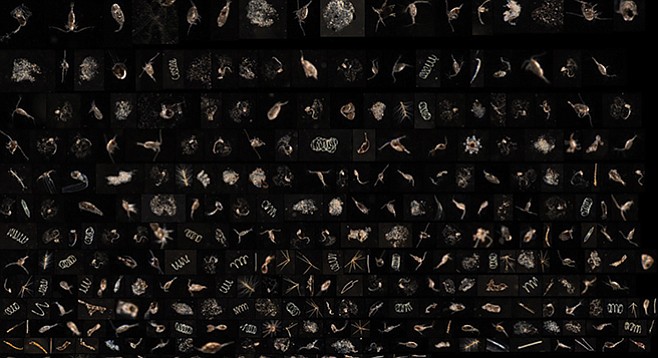 Facebook
Facebook
 X
X
 Instagram
Instagram
 TikTok
TikTok
 Youtube
Youtube

Every day under the Scripps pier in La Jolla, two cameras capture thousands of images of the weird and wonderful organisms called plankton. “Plankton,” a Greek adjective that can mean “drifter,” is a diverse group of tiny living things that is the base of the aquatic food chain. Many plankton are microscopic or invisible to the naked eye. Larger animals, like whales, feed on them by filtering huge quantities of water while they swim.
Recently, Jules Jaffe of the Laboratory for Underwater Imaging at Scripps noticed an unusual variety of plankton in the images compiled from a December day. Jaffe sent an email to his colleagues, many of whom were as awed as he was to see so many different shapes. In the series we see copepods — “the guys with antenna,” which are “the most numerous multi-cellular animals in the ocean and perhaps on the planet.” We also see diatoms — “the straight and coiled species that create houses of glass to live in.” Diatoms build outer cell walls of silica, a major ingredient in glass. The brush-like organisms are a type of plant.
Peter Franks, who studies phytoplankton and red tides at Scripps, said that a sudden increase in phytoplankton, called a “bloom,” is typically seen during the spring, when the waters warm up. Recent images from before the new year showed an abundance of zooplankton—animals, and then, he said, “after the new year we saw a dramatic appearance of chain-forming diatoms,” which are not animals.
Jaffe, who said he is “someone who invents instruments” and is not a biological oceanographer, declined to elaborate on what might be the significance of the greater-than-normal diversity seen that day in December. He said that often they see smaller neighbors to these and “wonder if they are merely hanging out or if they are eating each other, or if there is some other more interesting symbiotic relationship. This is something, that for sure, we know extremely little about.”
Visit spc.ucsd.edu to see the latest plankton pictures.


Every day under the Scripps pier in La Jolla, two cameras capture thousands of images of the weird and wonderful organisms called plankton. “Plankton,” a Greek adjective that can mean “drifter,” is a diverse group of tiny living things that is the base of the aquatic food chain. Many plankton are microscopic or invisible to the naked eye. Larger animals, like whales, feed on them by filtering huge quantities of water while they swim.
Recently, Jules Jaffe of the Laboratory for Underwater Imaging at Scripps noticed an unusual variety of plankton in the images compiled from a December day. Jaffe sent an email to his colleagues, many of whom were as awed as he was to see so many different shapes. In the series we see copepods — “the guys with antenna,” which are “the most numerous multi-cellular animals in the ocean and perhaps on the planet.” We also see diatoms — “the straight and coiled species that create houses of glass to live in.” Diatoms build outer cell walls of silica, a major ingredient in glass. The brush-like organisms are a type of plant.
Peter Franks, who studies phytoplankton and red tides at Scripps, said that a sudden increase in phytoplankton, called a “bloom,” is typically seen during the spring, when the waters warm up. Recent images from before the new year showed an abundance of zooplankton—animals, and then, he said, “after the new year we saw a dramatic appearance of chain-forming diatoms,” which are not animals.
Jaffe, who said he is “someone who invents instruments” and is not a biological oceanographer, declined to elaborate on what might be the significance of the greater-than-normal diversity seen that day in December. He said that often they see smaller neighbors to these and “wonder if they are merely hanging out or if they are eating each other, or if there is some other more interesting symbiotic relationship. This is something, that for sure, we know extremely little about.”
Visit spc.ucsd.edu to see the latest plankton pictures.
Comments